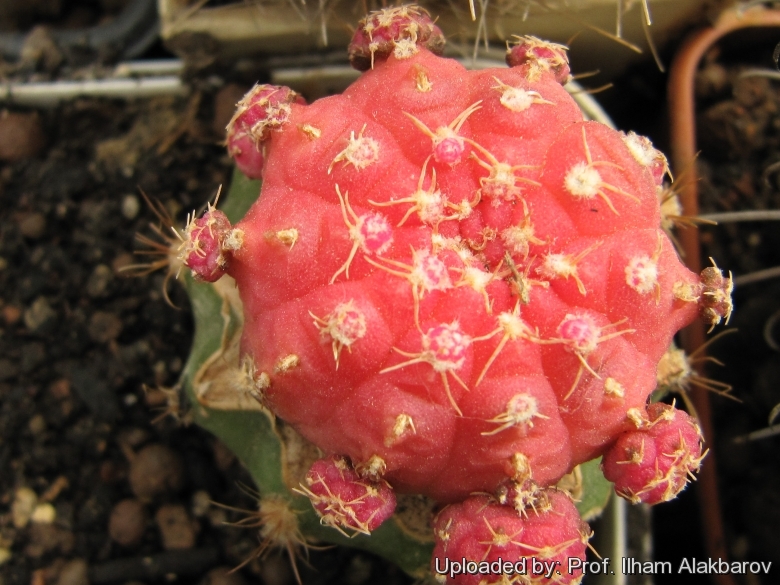Accepted Scientific Name: Gymnocalycium ragonesei A.Cast.
Lilloa 23: [5], fig. 1950 'ragonesii'

Gymnocalycium ragonesei f. rubra Photo by: Prof. Ilham Alakbarov
Origin and Habitat: Garden origin (Nursery produced cultivar)
Synonyms:
See all synonyms of Gymnocalycium ragonesei
back
Accepted name in llifle Database:Gymnocalycium ragonesei A.Cast.Lilloa 23: [5], fig. 1950 'ragonesii'Synonymy: 7
back
Description: Gymnocacalycium ragonesei (Sometimes wrongly spelled “ragonesi” or “ragonesii”) is a very small, dark skinned cactus resembling a round brown rock with white flowers usually in clusters from June to September.
Forma rubra (red form): The red schizochromic form (Gymnocalycium ragoneseiSN|21425]]SN|21425]] f. rubra) has bright orange-red stems due to the absence (or reduced production) of chlorophyll pigments: every other pigment is present at normal levels, the dominant green colouration is lost, but will still more than likely have normal other pigments that give the yellow overall appearance of the stem. This form with red stems is very attractive and highly prized. This schizochromic form is almost always seen grafted on stronger columnar species, and cannot can be grown on its own roots.
Habit: It is a slowly growing succulent species, usually solitary, but sometimes cespitose.
Stem: Very flattened globose, almost disk shaped, dark red or purplish1,4-2,5 cm tall and up to 5(-7,5) cm in diameter.
Ribs: 7-10, very flat, separated by poorly delineated transverse furrows.
Spines: Short, 5-5, usually 6, thin, almost hairlike, pale creamy-white to greyish-white, with darker tips, to 3 mm long, spidery, flattened against stem (rarely sticking out - easy cactus to handle).
Flowers: 2-3 at any one time near centre of plant, funnel shaped with narrow floral tube, creamy-white with a dull red throat, up to 3-4(-5) cm long, 3-4(-4,5) cm diameter.
Blooming season: Flowers are produced in late spring and remain open for up to twelve days.
Fruits: Slender, ovoid or spindle shaped, greenish brown, to 2,5-4 cm long, grey with pale edged margins.
Subspecies, varieties, forms and cultivars of plants belonging to the Gymnocalycium ragonesei group
Bibliography: Major references and further lectures
1) Trevisson, M., Demaio, P. & Perea, M. 2013. Gymnocalycium ragonesei. In: IUCN 2013. "IUCN Red List of Threatened Species." Version 2013.2. <www.iucnredlist.org>. Downloaded on 31 December 2013.
2) Edward Anderson “The Cactus family” Timber Press, Incorporated, 2001
3) David R Hunt; Nigel P Taylor; Graham Charles; International Cactaceae Systematics Group. "The New Cactus Lexicon" dh books, 2006
4) Roberto Kiesling, Omar E. Ferrari “Cien cactus argentinos” Editorial Albatros, 2005
5) James Cullen, Sabina G. Knees, H. Suzanne Cubey "The European Garden Flora Flowering Plants: A Manual for the Identification of Plants Cultivated in Europe, Both Out-of-Doors and Under Glass" Cambridge University Press, 11/Aug/2011
6) Hans Krainz “Die Kakteen: eine Gesamtdarstellung der eingeführten Arten nebst Anzucht- und Pflege-Anweisung” Franckh'sche Verlagshandlung” Lfg. 59. 1974
Cultivation and Propagation: Variegated and albinous cacti are regarded as choice and difficult in cultivation, but despite that many of them are relatively easy to grow. But be aware that they cannot tolerate prolonged exposure to direct sun light (especially during the hottest summer days), so grow them in half-shade or under filtered sun. They are sometime seen as grafted plants, but many grow well on their own roots, too.
On the contrary, the albinos can survive only if grafted on a strong green base.
Use mineral well-permeable substratum with little organic matter (peat, humus). Water sparingly from March till October and keep perfectly dry in winter at temperatures from 5 to 15 degrees centigrade. (In general these plants are more tender and cannot endure freezing temperatures ) In the rest period no high atmospheric humidity!!
Propagation: Usually by seed. Plants are often grafted onto column-shaped cacti.










